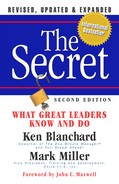Appendix:
Debbie’s Secret Notes
SEE THE FUTURE
To envision and communicate a
compelling picture of a preferred future.
The principle behind the practice: Leadership always begins with a picture of a preferred future.
Single-word focus: Vision
Key Questions
• What do I want our organization (team, group) to accomplish? What would that look like? How would we measure our success?
• What do I want to be true in the future that is not true today?
• Why should others care about this preferred future?
• How will we measure our progress?
Caution: Like water in a bucket, vision evaporates and must be constantly replenished—that is, communicated.
ENGAGE AND DEVELOP OTHERS
To recruit and select the right people
for the right job while creating an
environment where people wholeheartedly
invest themselves in achieving the vision.
The principle(s) behind the practice
• As people’s engagement level rises, so does the probability of success.
• Helping people grow pays huge dividends.
Single-word focus: People
Key Questions
• What do engaged people look like in my context?
• In the past, what factors have led me to be fully engaged?
• Which of these factors are missing in my followers?
• What do my people need to be more engaged?
• How can I help my people grow—as a group and individually?
Caution: One size doesn’t fit all. People have specific and unique engagement and development needs.
REINVENT CONTINUOUSLY
To possess a never-ending
focus on improvement.
The principle behind the practice: Progress is impossible without change.
Single-word focus: Improvement
Key Questions
• As a leader, how do I need to change?
• What should my developmental focus be for the coming year?
• In what arena do I want a different outcome?
• What needs to change to make that desire a reality?
• What structural changes could we make to accelerate progress?
Caution: A failure to pursue and embrace new ideas leads to stagnation in people and organizations.
VALUE RESULTS
AND RELATIONSHIPS
To generate positive, measurable results and cultivate great relationships with those you lead.
The principle behind the practice: Ultimate success always includes both people and performance.
Single-word focus: Success
Key Questions
• What happens if I overvalue results? What happens if I overvalue relationships?
• Which is my personal bias as a leader—results or relationships?
• How can I compensate for the area that’s not my natural strength?
• How can my team help me in this area?
• What will be the consequences if I don’t broaden my definition of success?
Caution: Failure to value both results and relationships will undermine long-term performance.
EMBODY THE VALUES
To live in a fashion consistent with your stated values.
The principle behind the practice: More of leadership is caught rather than taught. In other words, people watch the leader and learn from his or her example.
Single-word focus: Credibility
Key Questions
• What values or beliefs do I want to drive the behavior of my organization?
• How can I communicate these values?
• Which of these values do I most consistently model?
• Which of these values do I need to work on?
• What are my actions communicating?
Caution: If the leader doesn’t embody the values, the trust of his or her followers will erode, and ultimately the leader will forfeit the opportunity to lead.
Food for Thought
• What have I learned about leadership during this journey?
• Why does it matter?
• What do I do with all that I’ve learned?
• What am I willing to do today to improve my leadership?
• What one thing can I put into practice this week?
• Who can I ask to help me?
THE ULTIMATE QUESTION
Am I a serving leader or a self-serving leader?
